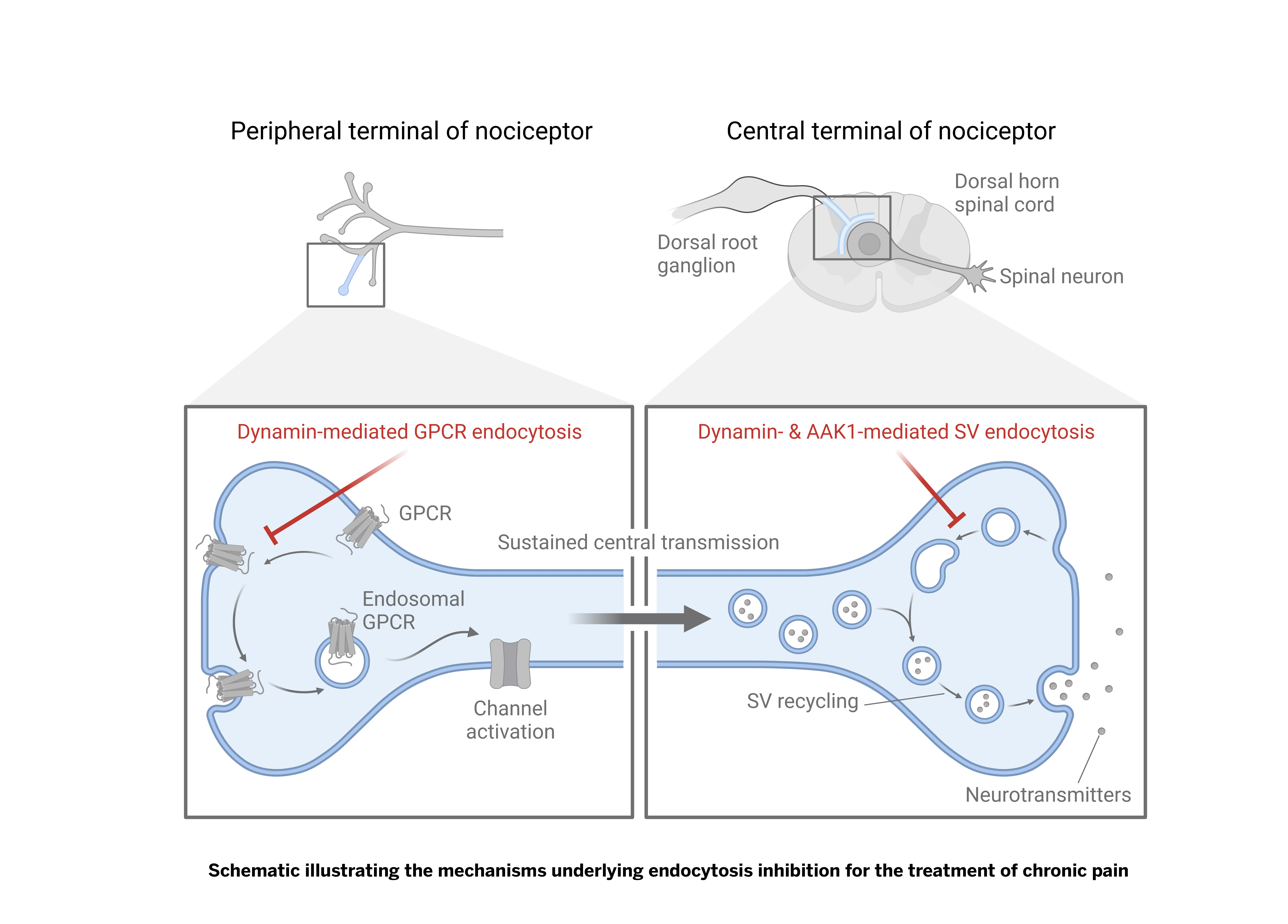Targeting Endocytosis in Nociceptors as a Non-Opioid Treatment Strategy for Chronic Pain

Unmet Need
Innovative and multi-modal, non-opioid treatment strategies for chronic pain.
Technology
The Bunnett Lab has uncovered the critical contribution of endocytosis to synaptic pain transmission in nociceptive circuits in the spinal cord and demonstrated the effectiveness of selectively targeting endocytic machinery as a novel strategy for treating chronic pain (see schematic). In proof of concept studies (Tonello et al. Pain 2022), they found that inhibition of eight individual proteins associated with synaptic vesicle endocytosis (clathrin, dynamin-1, -2, -3, adaptor-associate kinase 1 (AAK1), and three other undisclosed targets), either with commercially-available small molecules or siRNAs, reduced synaptic transmission and endosomal receptor signaling, thereby reversing inflammatory, neuropathic and post-surgical pain, without any effects on normal behavior. As a next step, the inventors are looking to identify and optimize novel chemical matter (antagonists of the above targets) in a partnership with pharma/biotech to develop next-generation, non-opioid analgesics.
Background
Chronic pain is common, poorly understood and difficult to treat. Current treatments for chronic pain (e.g., µ-opioid agonists) are typically accompanied by adverse side effects such as respiratory depression, constipation, and addiction. Moreover, the redundancy of pain signaling pathways, whereby multiple receptors and channels can activate the same neurons, limit the effectiveness of receptor/channel-specific antagonists for the treatment of multi-modal forms of pain. However, central to all pain signaling circuits is synaptic vesicle cycling, which is required for the synaptic transmission of pain via neurotransmitters. Therefore, targeted inhibition of the machinery underlying synaptic vesicle endocytosis, specifically within presynaptic neurons in the dorsal horn of the spinal cord, offers a novel approach to effectively ameliorate a broad range of pain modalities, as an alternate to addictive opioid treatments. As an additional benefit, this approach would also block endosomal pain signaling mediated via pronociceptive receptors (e.g., GPCRs), by inhibiting the formation of endosomes, thereby further abrogating the transmission of pain.
Applications
- The treatment of chronic pain, including but not limited to:
- Inflammatory pain related to inflammatory bowel disease, arthritis, migraine, etc.
- Allodynia: cancer-associated pain or chemotherapy-associated pain
- Postoperative pain
- Neuropathic pain
Advantages
- Novel strategy: Targets endocytosis of neurotransmitters in nociceptors
- Broad efficacy: Capable of blocking multi-modal pain signals from disparate receptors and channels.
- Safe and tolerable strategy: Endocytosis inhibition reversed pain in rodents without affecting normal behavior.
- Fewer adverse side effects: This strategy is less likely to cause addiction and other side effects common to opioid treatments.
POC Studies
https://pubmed.ncbi.nlm.nih.gov/36378744/
Intellectual Property
NYU has filed a PCT application covering the method of targeting endocytic machinery in nociceptive circuits (8 proteins aforementioned) for the treatment of pain.
-
expand_more mode_edit Authors (1)Nigel Bunnett, PhD
-
expand_more library_books References (1)
- Tonello R, Anderson WB, Davidson S, Escriou V, Yang L, Schmidt BL, Imlach WL, Bunnett NW (Nov 14, 2022), The contribution of endocytosis to sensitization of nociceptors and synaptic transmission in nociceptive circuits
-
expand_more cloud_download Supporting documents (2)Product brochureTargeting Endocytosis in Nociceptors as a Non-Opioid Treatment Strategy for Chronic Pain.pdfMarketing BriefNYU - Targeting endocytosis in nociceptors - Marketing Brief - BUN01-01.pdf (246 KB)